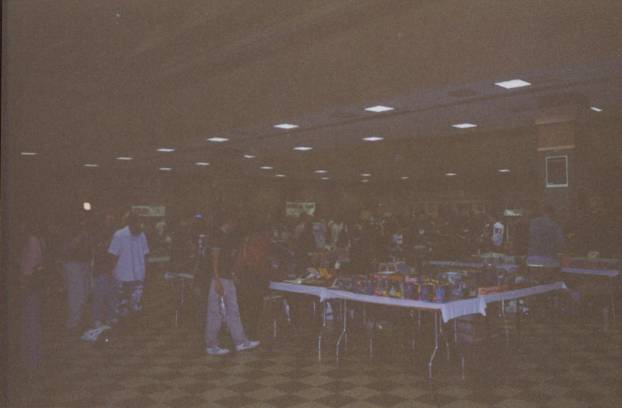
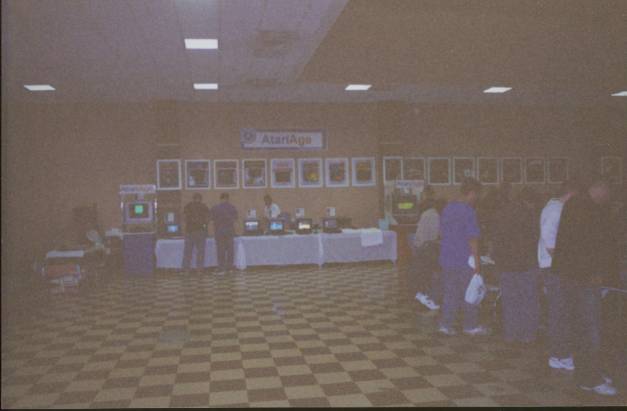
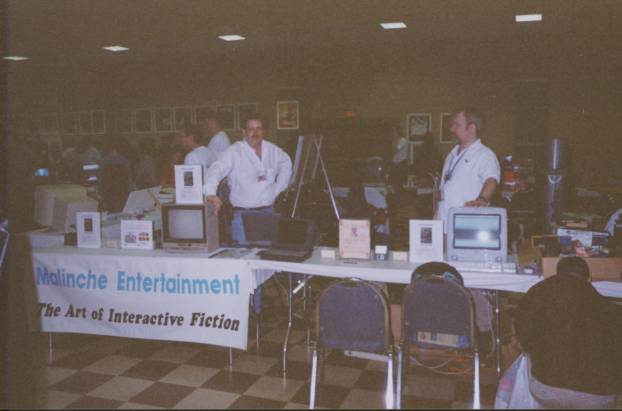
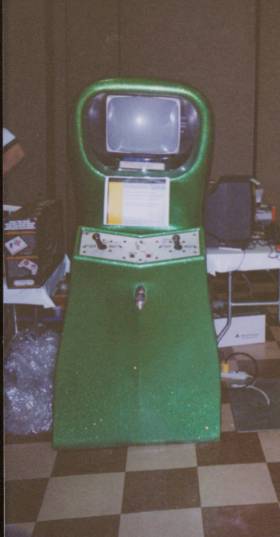
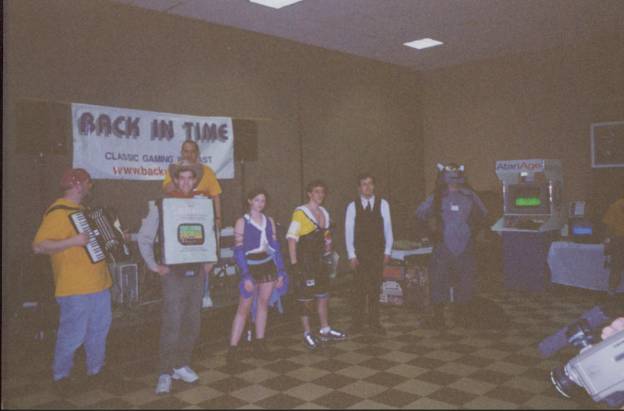
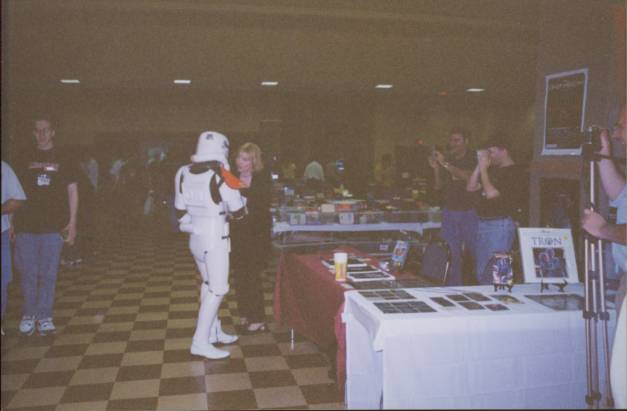
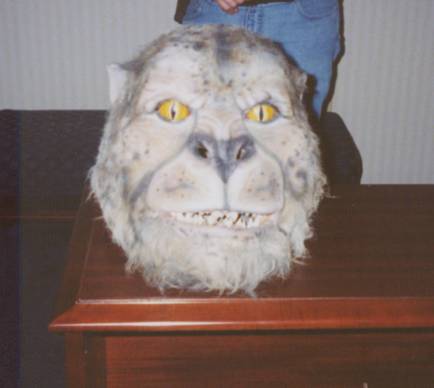
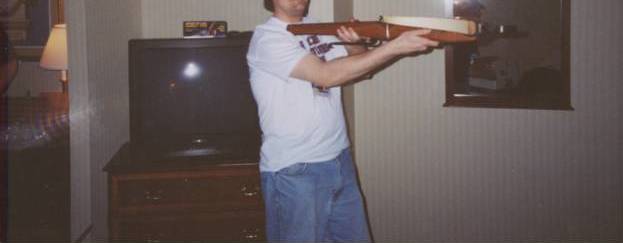
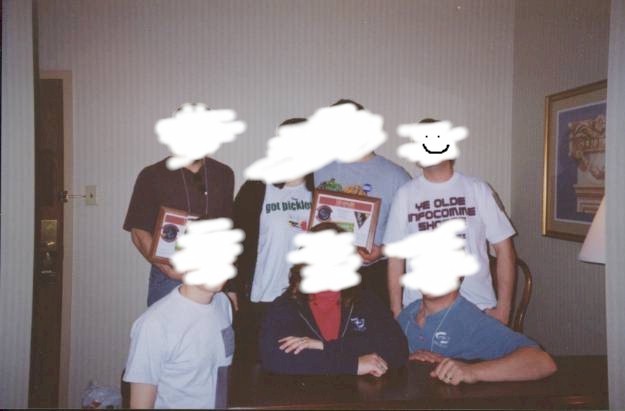
 I'm a movie star.
I'm a movie star.
Like many Hollywood stories, my rise to fame happened overnight. One day I'm a nobody driving an economy rental car through the outskirts of Philadelphia, the next I'm in front of a camera at a taping in the Origin Museum's Radisson suite, a clandestine gathering unknown to the console-gaming masses milling about PhillyClassic 4, way down at the other end of the hotel complex. No, I know what you're thinking, and it's not that kind of movie... though there is a Leisure Suit Larry beach towel involved.
Hmm, let me rewind a few hours...
Saturday:
The doors open at 10:00, and the rush is on. Step One, locate and acquire any collectible computer software packages on the premises. I find one vendor who has a bunch of empty Commodore and Atari 8-bit game boxes, cheap, and walk away with three Scott Adams plastic cases and a Bantam Imagic Sherlock Holmes tri-fold. After a quick initial sweep, I go back through it all again, taking my time. There's a ton of cartridge stuff, but you have to look closely at all of it because there can be disk and cassette software mixed in. It's still overwhelmingly console-based, though. The Digital Press booth is good. I snag an early Sirius arcade title for $3.00. Bargains exist, but you have to seek them out. While prices on commons tend to be pretty reasonable, often less than what you'd pay on eBay (and no shipping costs), there's still plenty of expensive rarities geared toward hardcore collectors.
One of the most interesting stops is the AtariAge booth. These guys do professional-quality packaging for the bulk of new homebrew creations for the Atari console systems: Cartridge labels, manuals, and boxes that look like original Atari releases. Amazingly ambitious, albeit a tad unsettling from an anti-counterfeiting standpoint. Not to worry, though, the AtariAge crew are true hobby supporters, in it for fun rather than profit, and they only do boxes for their own releases. They've got a 5200 sequel to Warren Robinett's Adventure due out this summer, and I had an opportunity to test drive the prototype. It looks phenomenal, with a larger area to explore; graphics that are near NES-quality; a game world with castles, houses, forests, hedge mazes, waterways, and a dragon that actually looks like a dragon.
Scouring the dealer tables takes most of the morning. PhillyClassic is much like the Classic Gaming Expo in Vegas, with about the same number of booths, but CGE felt more compact, in a slightly smaller ballroom. There's a lot more space between the tables here, and even an open area where attendees are chucking dirt-common Super Mario and Combat carts against the wall. The chick from the movie Tron is here too, signing autographs and meeting fanboys. In the showroom next door, a computer sale with modern hardware and software is being held, but I never do make it over. Too busy playing the arcade stand-ups in the far corner.
Eventually I locate Pentari author Howard Sherman at the table Malinche Entertainment has set up. We back-and-forth a bit, about how sales are doing, about his strategy for marketing his games mainstream (something Cascade Mountain never did), about the increasingly sorry state of affairs in *ahem* a certain online forum. Quite a few people are stopping by to try the game out, and a lot of demo disks are given away. Howard appears determined to keep pushing commercial I-F, and I sincerely hope he earns enough to make it worthwhile. I mention our secret gathering tomorrow morning with the Origin Museum's Joe Garrity, and invite him to stop by, if he can get away from the booth.
Still no sign of Joe himself, whom I'm supposed to meet for dinner in a few hours, and I haven't been able to reach him by phone. Fortunately at these things you can often tell who's who by what they're wearing, so I scan the crowd for any Origin or Ultima-related garb. I finally spot him kneeled down, back to me, flipping through a box of glass arcade-game marquees. His T-shirt has the Escape from Mt Drash cover art on the back, with "Have You Seen Me?" underneath, milk-carton style.
I'd say Joe's enthusiasm for collecting may exceed even mine. Certainly his collecting experiences are more remarkable: He's visited Brittania Manor and met Richard "Lord British" Garriott in person, as well as David Watson (the real-life Iolo the Bard), and Denis Loubet (the cover artist for Origin's early games). His wife Paula is here at Philly too, along with Jeff Phillips, another Origin Museum staffer who lives in the area. (Joe later comments that I "look better" than the preconceived image he'd had of me. No wonder I'm a movie star: I'm software collecting's pretty-boy. B-)
I show him the booth where I bought the the empty Scott Adams cases, which has a few Ultima and other Origin boxes Joe can use. We have to wait, though, because the costume contest is on and the vendor is dressed as Pitfall Harry, in a cardboard vest with the Pitfall! cartridge label artwork, Indy-esque fedora, and a rubber scorpion on his shoulder. The other entrants are all characters from recent Japanese titles, I couldn't tell you who they were. Pitfall Harry wins best overall by an overwhelming margin (it is a classic gaming show, after all). Joe confesses he'd thought about entering with one of his Wing Commander costumes, but decided that wouldn't really be fair.
Speaking of which, afterward we're accosted by one Mark Wolfe of Level 1 Productions, who's making a DVDocumentary film about the PhillyClassic show and wants to do an interview with the two of us. (Here comes the part where I'm a movie star!) We head to Joe and Paula's suite, and while Nathan Bramble of Digital Video Documentaries gets the camera set up, Joe shows me some of the unique artifacts the Origin Museum has acquired, such as a Kilrathi head mask from Wing Commander III. It's a background one, not one of the animatronics used for speaking characters, but still an amazing piece. He also has Freddie Prinze Jr's actual uniform worn in the WC film (got it on eBay when the studio auctioned a bunch of props). My favorite item, though, has got to be the Ultima crossbow, handmade by Iolo as a prototype before Origin's legal department axed their plans to sell such a dangerous instrument as a commemorative keepsake. Joe says the hotel staff expressed some trepidation at seeing him carry this thing in. He actually let me fire it (unloaded of course) and it's got quite a kick.
Mark sits us down amid some of our prize items, lets us show off a few -- the aforementioned Leisure Suit Larry beach towel is my primary contribution to our makeshift backdrop -- and asks us some questions about the hobby, our roles in it, and our attitudes on various topics. To be honest, I can't even remember much of what I said. Joe, who's clearly had a lot of prior experience telling his story, does better than me, but assures me I didn't totally suck. We shoot about a half-hour of footage total, but I figure they'll probably edit it down to a few clips and sound bites for the final product. That's okay. I'm still a movie star.
We head out for dinner, and later meet up with Jeff's girlfriend at the mall where she works in the Sanrio store... the cutest, PINKEST place I have ever been to in my life. Wall-to-wall Hello Kitty crap, it's just unreal. Joe can't resist trying the cola-flavored bubblegum with the penguin character on it, and he shares a piece with me. It's HIDEOUS. (I vow by the Eight Virtues to someday make him pay for that. B-) We get back to the show just in time to catch the end of the Q&A session with Sid Meier -- yes, THE Sid Meier! -- and Joe gets him to autograph a PC4 T-shirt.
Sunday:
There's a brief panic at the Origin Museum: Earlier that morning the fire alarm went off in the Radisson, leaving Joe and Paula scrambling to save their irreplaceable treasures, carrying two, three huge boxes at a time out the doors. Thankfully, it's a false alarm.
I join the Origin Museum and Malinche crews for breakfast, and we find collector Dan Chisarick at the entrance to the show. Then it's back to Garrity's suite for more show-and-tell. Later Stuart Feldhamer and his wife show up. Everybody gets to look at the Wing Commander props, fire the Ultima crossbow, and show off some of the collectibles we all brought. Group pictures all around, then Howard has to run because everybody's got questions about Pentari and keeps asking where he is. (Visit his page for a great side-by-side of Stuart's Barbarian Zork and the Malinche Pentari folder.) Joe presents each of us with a framed set of Wing Commander IV patches.
We spend the entire morning and part of the afternoon in the suite, then Joe packs up the Museum and the others head back to the expo for the closing. I grab something to eat, then check in with Howard, who points me toward someone else who just stopped by. It's David Berk, one of the three founders of MobyGames! We talk a bit about Moby's recent addition of several classic console platforms, and their need to find some experts who can chronicle the timeline of that hardware. I direct him to the Digital Press guys at the other end of the showroom. History in the making? Time will tell.
About an hour before close, the vendors plummet their prices in an effort to avoid having to lug everything back home with them. I revisit a couple of booths and grab some more 8-bit disk software just so I can use the empty suitcase I dragged along. Howard's got a copy of Masterpieces he's raffling off to Pentari buyers. He draws the winner, and it turns out to be Joe. Once the arcade guys start hauling their stand-ups out, the show is officially over.
I had a great time, everyone. Thanks for meeting me there, and special thanks to Joe for his hospitality and his effort in bringing us all together.
The big question from everyone at the show was whether the interest would be there for a large-scale software collector's expo. Something like Philly or the CGE, but geared specifically toward old computers and software. Let me know, or stop by the Software Collectibles Mailing List. If enough people would be willing and able to attend, we can see about putting together a crew to organize it.
Things you can answer that would help us out:
Being in the Midwest I'm fortunate, as I could probably get just about anywhere in the States without too much difficulty. It might be a hassle for those of you on the east or west coasts, though, making it clear to the other side of the continent, and the time required for travel to/from North America for overseas collectors may be hard to justify for a two-day show. (Some console-gamers in Europe have already put together several of their own smaller gatherings in response to this logistical issue.) Let me know. I'd love be involved in something like this, but it'd have to be worth the time and trouble to set up.
Oh, and I promise to keep everyone informed once I hear about the release of the documentary movie I was in. Did I mention I'm a movie star? I just wanted to mention I'm a movie star. I just like saying it. I'll probably say it again before the end of this column.
(Had the same problem with my pics as I did at CGE, the ones taken in the huge ballroom turned out really dark. I'll post the ones from Vegas once I dig them out from the move.)
 |
 |
 |
 |
 |
 |
 |
 |
 |
On Shrinkwraps in Airports
Okay, the airline industry doesn't seem to have gone totally 1984 yet. I carried several shrinks back from PhillyClassic inside my baggage and they didn't touch them. My recommendation, bury them in with your clothes and be prepared to send them through the X-rays. (The signs claim they don't damage magnetic media, but you wonder about some of those older disks. But then, if you're not planning to open and use it anyway...)
The key is to not give any indication that you DON'T want it opened. It's those people's job to be suspicious, and if you specifically ask them not to open something they almost certainly will. One collector I talked to did this with some thrift games with the sides taped shut (more on that below), and security went through every one of them. And just TRY explaining the subtle indicators of an original shrinkwrap job to some uniformed goon reaching for his sidearm: "Okay, see the store stickers on the outside, plus it has the little pencil hole in the plastic..."
But if you don't show any anxiety at the prospect of a search, you can probably take shrinks through airports without incident. I did, however, have my PC Cyborg sent through the mail both ways, insured and registered, just to be safe (okay, less unsafe, but it did get back to me without incident).
Thrift and Adventure
Lesson #6 in collecting computer games: Learn to play the thrifts.
Slowly, as our hobby gradually becomes more mainstream, thrift shops are starting to catch on to us. This is very noticeable in the cartridge collecting world, where you can sometimes go into a thrift and see Atari 2600 carts priced at $5 - $10 apiece. Even junk titles, the dirt-common stuff you consistently find in every batch of games. You've probably noticed it at least once with older software, too. Plus you hear stories of employees getting the good stuff as soon as it goes in the donation bins. Fortunately these places don't seem to truly be in the know, they've likely just heard that "old games are collectible". So if they price stuff high, they price it ALL high, not bothering to research collector values.
It stands to reason that these thrifts probably get so much miscellaneous stuff in other areas, they simply don't have the time or inclination to become vintage game experts. Still, it's frustrating for those of us who like bargain finds, so natrually we have this desire to better educate the public. The key is balance, letting the average non-collector know there's interest in old games so they don't just throw them out, but not enough to get them price-crazy so you end up paying more for everything. It's a good idea to keep them guessing as to what exactly is considered valuable, even if that means buying up the crap games if the price is low.
Like eBay, or any other vintage game source for that matter, thrift stores present their own array of little quirks and nuances you have to deal with. When you buy from a thrift, you always take your chances. There's no assurance the disk still works, and unless you're familiar with that specific game you can't even guarantee it's complete. In fact, for awhile one of the most common blight on thrift stores was missing disks. Dishonest jerks would simply pull the game media out of the box and walk off with it. The interesting point we can glean from this is, the uninitiated tend to assume the disk is the best item inside the package. (Which is partly true... I've already established the label as the most valuable piece of a game. B-) But when an idiot shoplifter takes only the disk, he'll leave behind the trinkets, the cloth map, code wheels or other copy-protection, even free cluebooks and other loose materials commonly stuck inside boxes by thrift store employees who just don't know any better. Unfortunately these are the same people who might pitch a Suspended mask if they notice the disk is gone.
With strong anti-theft protection in most major retail stores, I suspect thrifts are being hit instead. Places like Goodwill and Salvation Army can't afford sophisticated electronic detectors at the doors, or cameras watching every foot of the premises from multiple angles. So they've developed their own, low-tech solutions for rudimentary security. Coping with these measures, making sure the game is worth picking up, all without letting on that you essentially ARE getting a choice title for a "steal", is the art of playing the thrifts.
The most common and most insidious device in a thrift shop's anti-crime arsenal is the tape. Oh, lordy, how I DESPISE the tape. Stores put a piece of Scotch or masking tape over each end of the box to discourage thieves from opening them and swiping easily-pocketed items like the disks. Tape is a pretty clear sign that the store doesn't want customers digging through the contents. Problem is, this directly contradicts Lesson #1 in collecting computer games: "Always look in the box!"
So what do you do? Do you slip over into a corner and pretend to be rooting through the bin of paperback books or the shelves of old LP records, while secretly slitting the tape and lifting the box lid to take a peek? Or do you track down a salesperson and ask if it's okay? The problem with that route is, first you have to wait until they finish checking out the endless line of customers that keeps piling up, all of whom are old ladies or mothers with screaming kids, and all of whom have approximately 70 articles of clothing they decided to purchase just as they saw you approaching with the game. For the most part, I'd say you're probably safe opening the box, especially if there are mostly teenagers working there. They tend to not be very watchful, particularly if you don't look like the guilty type. Even if you're confronted, you can stand your ground: Checking that the disks are there or that the game is complete are perfectly valid explanations.
The other more serious problem with tape is, if the wrong kind is used, it can leave glue marks that are a pain to remove, or even worse, shear the box when pulled off. Some places I've been to, instead of using removable stickers, will even write a price directly on the game, in permanent black marker! So the stratgy becomes, find a way to tell these places it's not okay to deface the boxes, without letting on that the games can be worth a lot more with the outer packaging in good condition (again, we don't want prices going up).
That's a pretty narrow line to walk. One good trick is to say you want the games to look nice because you're buying them for someone else. Which technically is true... you just don't know who they are, because they haven't won your auction yet! But the store won't know that, they'll assume you're giving that Caverns of Callisto as a gift. (Shyeah, as if! B-) Except what if you find multiple copies of the same really good title, and a pesky clerk looks at you strange and asks why you're buying them all? In this case I'd just say I have a bunch of gamer friends, and they've all been looking for a copy, it's a popular game. If anyone ever does come right out and insinuate that you're just buying stuff up to resell it on eBay at a profit, well, you can always claim you trade over the Internet, rather than sell.
Or, going back to dealing with taped boxes, you could try the indirect approach, suggesting to the store people how it's probably a pain to open and reseal the package every time someone needs to check the contents (and they have to allow that, because what if there's a disk missing). Or that keeping software in a glass display case would deter disk thieves AND save the time of taping all the edges up. A number of thrifts have already begun doing this.
Cases have their own array of problems, though. Unlike opening a taped box, I'm pretty sure the store staff would say something if you got behind the register counter and started going through their display cases. So you're back to asking to see the games, which means getting someone's attention AGAIN. Then once you have them, you have to successfully communicate which game you're interested in, then wait silently screaming inside as they run their finger along the row of packages, looking for it... and they always miss it on the first pass. Sometimes you try to help them find it faster. ("To the right. No, I meant MY right. Okay, back, back, too far, other way... YES! That one!") Then you check the contents and discover disk #2 is missing, or maybe there's a hideous rip in the back you didn't notice until you're holding the box. Or you find out it's priced at like $20 -- Why do they never put the prices facing out through the glass where you can see them? And it's like they EXPECT to be rewarded for their efforts with a purchase, and they get all pissy that you're not going to buy it after all that.
Inflated prices can be another issue you have to deal with. With old games for obsolete systems it's usually not a problem (unless everything is overpriced), but if you're looking at a recent title that may have just had a price slash at retail, it's possible the thrift hasn't caught up with the industry yet. They haven't marked it down, so it's almost the same price used as a new one at EB Games. Personally I try not to complain too much about prices, since that's a good way to lose storekeeper affinity. Nothing wrong with letting them know about a price drop and making a reasonable counter-offer. Worst case scenerio, they say no, and you either pay the higher price or pass, depending on how essential it is to own the game.
Sometimes sneaky people try to circumvent costs through sticker-switching, peeling a price tag off one item and putting it on another. Stores have caught on to this, though, and a lot of thrifts now have policies posted everywhere, stating that they'll refuse to sell an item if the prices are switched or removed. But this ends up hurting the honest collector, too: What about cases where someone actually forgot to put to put a price on it? It's happened to me, more than once, on a good find. I've found that if you have an honest face, the clerks will routinely ignore the rules and quote you a price. (But let's not abuse this by removing stickers ourselves, okay? A lot of thrifts support local churches or community outreach programs. Karma, people.) Even if they do refuse, all is not lost. Having them put it aside and "ask the manager" is a good strategy, as you can check back the next day and see if it's had a price put on. Sometimes this works on overpriced items as well.
Waiting can bring its share of risks, though, the most obvious being that someone else could stop in and decide it's worth that much to them. Then they get it, and you miss out. Oh, you can try the hiding-it-behind-some-books trick, but other collectors know that one. And the thrift itself may have policies about how long unsold merchandise is allowed to take up shelf space. If it doesn't move within X time, they may give up and decide to pitch it. Anyone out there actually worked in a thrift store? How strict are these places on this rule? I'm sure everyone's been to some that are a complete mess, stuff just thrown anywhere there's room, and I can't imagine staff going through it all every week to check what's expired. On the other hand, I've definitely seen them dumping clothes, pots and pans, etc., into big green dumpsters out back. (We are one wasteful country, I gotta say.) Most likely it depends on the individual store's influx of new stuff: If they get a ton of donations coming in the door, something's gotta go out to make space for it.
In the end, it all boils down to whether it's worth it to you. Is it really a huge deal if you only make $7 instead of $10 reselling that Bard's Tale? Only you can choose the point at which picking the game up becomes more trouble than it's worth.
Finally, what do you do if you run across a bunch of stuff that MIGHT be valuable, but it's not really your area of expertise (i.e. business software, or console games)? You definitely don't want to pass up something that could supplement your collecting budget with an extra hundred dollars or so. But how do you make sure you're not just getting a pile of junk you'll be stuck with because no one else will buy it? I personally carry a pocket notebook and a pen with me every time I go thrifting. If I see something I'm not sure about, but that looks promising, I'll jot it down and look it up on eBay later, make a return trip if necessary. (TomMage and I once made a small fortune between us selling sealed ClarisWorks and Mac OS 8 software that a store was dumping for $7 apiece.)
Another handy reference is the Digital Press Collector's Guide to cartridge games, which lists titles, their relative scarcity, and suggested prices. It's a huge, conspicuous tome, though, not the sort of thing you want every thrift in town seeing you lug through the door. A good trick is to go in wearing a backpack with the guide inside, then slip into the restroom if the store has one, or if not, grab a couple pieces of clothing off the racks and hide out in a changing room to look up prices in private. B-) Some places make you leave bookbags at the counter while you browse ('nother anti-theft measure), so you may end up making a trip out to the car to check values there. The pocket notepad comes in handy in this situation, so you don't have to remember all the titles you saw.
And if you really want to get hi-tech: Carry a laptop or PDA with wireless Internet, so you can search eBay's completed auctions on the fly. Currently this type of service is only available around major cities. But perhaps someday "vintage game broker" will be a viable career: Thrifters connecting to an online database of collector values, chatting live with potential buyers, negotiating a price on an item that hasn't been bought yet. All behind the curtain of a changing room, of course, so the store people can't see. B-) I'd quit my day job to do this.
Oh, and one final tip on continuing to get bargains in thrifts... Don't let any store people read this column.
Dysan Dissertation: A New Beginning
Can everyone stand just one more article on the Infocom Dysan packages? The guy I bought my boxed Dysans from had some interesting info I thought was worth sharing. He writes:
|
"The games I'm selling you (and have already sold you) were purchased in Fresno, California in the 1980's, but don't try to pin me down to an exact year. They were being sold by a person who bought old, outdated and closeout type software. I was the original purchaser, and purchased
the seven games during three stops by the above person locally. They usually set up for a weekend sale at a local motel in a couple of meeting rooms, and on Sunday evening tore the show down. I believe they covered the central valley and northern part of California, and stopped in the major cities on about a one month circuit. I think the guy would recruit locals to help him, and usually compensated the help with free software.
"I don't know how many Dysan software copies the fellow had, but they covered a large folding table (4 ft X 8 ft) about 10 high. Since I already had the Zork series, I only purchased the games that I didn't have, hence I didn't purchase any of the Zork series from him. I believe they were shrink wrapped when purchased, and I think they all had the 3 1/4" program media disk in the box as well... I believe you were right on the money when you said that these games were produced to take advantage of a new program media type - namely the 3 1/4" floppy disk. "When Sony brought out their new version of floppy disk - the 3 1/2" - I believe it doomed the 3 1/4" style, and Dysan probably figured that to recoup some of their loss, they would use an existing format - the 5 1/4" - and copy the games to that format - hence the little round white stickers on the outside of the boxes proclaiming 5 1/4" media for the IBM AT/XT. "Lastly - In answer to you observation of how little there seems to be in the boxes, originally there was a piece of eggshell foam in the bottom of the box to help take up some of the space and to protect (cushion) the contents." |
C.E. talking again... I should add that these packages seem to have come with a combination of Infocom and Dysan errata. The original Interlogic reference cards for the games are included, as are the "Our Circuits, Ourselves!" catalog and sometimes a "Bilk & Wheedle" InvisiClues flyer, but Dysan printed their own license agreements (in triplicate, no less). Registration cards can vary: I've got one with an "Inside Scoop" Infocom card and a couple with Dysan's. Unfortunately my seller's 3-1/4" disks were thrown out as unneeded. If anyone has one I'd love to see a pic.
In case anyone needs the list, here are all the Infocoms available in the Dysan packaging:
And that's the last I'll write about the Dysans, I promise. I'll just have to find some other subject to bring up constantly.
I'm a movie star.
| <-BACK | ->HOME<- | <HELP> |